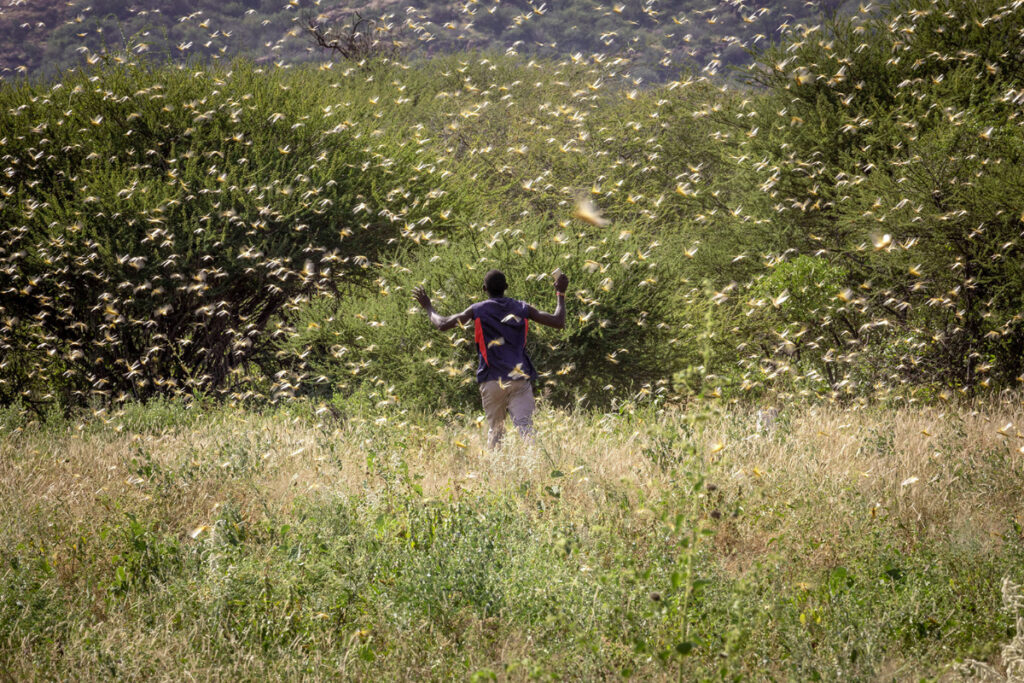Locusts are the primary agricultural pest of the world. Out of 5000 different species of grasshoppers, only nine species have been recognized as locusts. These nine species proved havoc for agriculture for years. We should have a clear understanding of the biological background, classification, impact on agriculture, marching time, and history of the invasion of locusts so that we can take steps about their control.
Before going into depths of Desert Locust, let’s have a look at its present attacks in Pakistan. National Disaster Management Authority said that Balochistan is the most affected area by the attack. A swarm of locust has spread to 52 districts of Pakistan, including 31 in Balochistan, ten districts in Khyber Pakhtunkhwa, 6 in Sindh, and five districts in Punjab. Fruit crops that have damaged by locust in Balochistan are apple, cherry, and peach, etc. It also ruined onion crops in Balochistan.
Desert Locust Schistocera Gregaria is known as one of the most voracious insects, which is polyphagous and can eat all types of vegetation that it comes across. Desert Locust is a species of swarming, migratory, short-horned locusts known to occur in desert areas with favorable agro-ecological conditions. Historically swarm of Desert Locust has always been a threat to agricultural production and food security in Africa, the Middle East, and Asia. This occasional pest produces two to three generations per year with a life cycle of 12 weeks. Almost 30 countries are potentially prone to Desert Locust, covering the area of about 16 million kilometers. In comparison, 60 nations are under the threat of invasion, covering the world area of about 29 million kilometers. This insect, after consuming the vegetation of an area migrates to another region where food is available to them.
Locusts show polyphenism i.e. they appear in two phases, gregarious phase and solitary phase.
- Gregarious Phase: Crowding induces the gregarious phase and which is most notorious for its tendency to aggregate and form a massive swarm.
- Solitary Phase: Isolation leads to the solitary phase in which individual activity avoids other locusts.
The differences between these two phases are collectively termed phase characteristics, extending from behavior and ecology, through morphology and anatomy, to physiology and biochemistry. Behavior can change within hours for some species, but other traits, such as morphology, can take several generations to shift entirely. This plasticity creates unique challenges; for instance, the gregarious phase locust, the Desert Locust, a single swarm can cover 1200 square kilometers.
One of the classifications of locusts is according to their feeding guilds,
- Forbs and tree feeding locusts
- Mix feeding locusts (grasses, forbs, and trees)
- Grass-feeding locusts.

Desert Locust is one of the mixed feeding locusts, and this tends to eat broadly from many plant families. This adaptation allows them to persist in and migrate through many landscape types. It also makes plagues a significant threat to livestock forages and pastures as well as the broad array of crops. This specie prefers overgrazed or disturbed habitats, potentially due to an increase in bare soil for lying egg and thermoregulation.
Gregarious locusts eat plants containing alkaloid hyoscyamine that solitarious locusts avoid and actively consume it, likely to gain gut-content mediated toxicity and avoid predation. Moreover, gregarious locusts are less discerning when faced with diet with nutrient imbalance as compare to solitarious locusts. It may be due to several reasons. Firstly, migrated individuals may encounter increased food diversity and this breadth may allow the gregarious individuals to redress nutrient imbalances. Secondly, groups of gregarious locusts may cross vast areas with no food, and a narrow host plant breadth may mean starvation. This diet expansion, in combination with aggregation likely heightens agricultural impacts. Indeed, locusts can cause 80 to 100% crop losses across affected areas.
A Desert Locust adult can consume roughly its weight i.e., about 2 grams of fresh food per day. The notorious 1915 locust attack in the Middle East, for example, resulted in wiping out a largely underestimated 536,000 tons of food. According to FAO, in modern days, African nations spent US 30 million dollars in anti locust campaign.
When an invasion occur all type of vegetations are subject to attack. Damage can be considerable on all types of crops: annual rain-fed crops as well as perennial crops, tree cultivations, and irrigated crops. Locally food competition between locusts and livestock leads to a deterioration of the vegetation and the soil. Locusts invasion can, therefore, lead to desertification at the local level. These invasions occur during periods when rainfall is highly favorable to the development of crops increases their economic impact.
Swarming is a hallmark of locust behavior. Swarming is a result of attraction and aggregation tendency of locusts in the gregarious phase. Locusts band will typically have one period of marching in the forenoon and another in the afternoon, strongly depend on weather conditions such as temperature, but also on clouds obscuring the sun, as well as on rain and cold wind. Mostly Desert Locust’s marching took place from just before noon to two hours before sunset. The marching band can cover very different areas, from a few hundred square meters to several kilometers. The shape of the marching band can also vary, ranging from columnar to frontal structure.
The Desert Locust crises started back to May 2018 when a cyclone passed over a vast unpopulated desert to the southern Arabian Peninsula, filling the space between the dunes with ephemeral lakes, which allowed locusts to breed undetected. This was further amplified in October 2018 by cyclone Luban, which spawned in the central Arabian Sea and then marched westward. Locusts grow exponentially in this kind of climate, and ultimately these two 2018 cyclones enabled three generations of wildly successful locusts breeding in just nine months, increasing the number of these insects roughly 8000 fold.
This article is written by Irfana Yasmin, who is a student of MSc Botany at Quaid-i-Azam University, Islamabad.
Also Read: The revival of Indus river Dolphin


